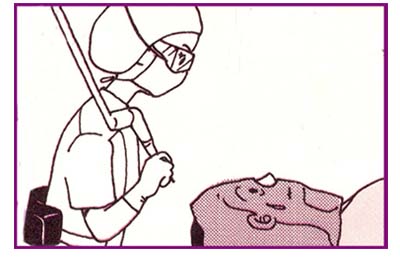The carbon dioxide laser has made bloodless surgery possible. Absorption of laser energy by water in the tissue produces so much heat that it vaporizes the tissue (turns it into vapor or particles that dissipate in the air). The accompanying thermal damage to the surface of the remaining tissue extends no more than 100 microns, but is generally sufficient to seal blood vessels, nerve endings and lymphatic vessels. That means that bleeding can be kept minimal during carbon dioxide laser surgery, and practially no pain or swelling is experienced afterwards. Another advantage of laser surgery is the fact that a laser wound heals faster than the wound of the same extent and depth caused by another surgical instrument. This is attributed to the bio- stimulative effect that every type of laser is thought to possess.
The carbon dioxide laser can make a hole as small as a needle puncture. It is a useful tool for cutting tissue that readily bleeds (ex. the mucous membrane), as in transconjunctival lower blepharoplasty for improving baggy eyelids. It is also extremely useful for removing small skin tumors such as moles and warts. It can also peel the skin to remove brown spots or resurface the skin to correct irregularities such as acne scars and wrinkles. Lastly, it can literally puncture facial broken vessels to make them disappear on the spot.

laser
As with any invasive procedure, the need for a compromise between the risk of scarring and insufficient effect is the reality that the patient has to accept, though laser surgery compares favorably with other surgical methods in this respect. For instance, tissue removal by electrosurgery or cryosurgery is based on the process of crusting or scabbing and sloughing: The dead tissue turns into a “crust” or “scab” and subsequently comes off. There is hardly any visual control over the extent of the damage produced by these methods. Better damage control makes laser surgery cosmetically superior to other surgical procedures. After removal of skin tumors as well as laser peeling and resurfacing, wound care and application of a dressing is required for a week to a few weeks, depending on the extent and depth of the resulting skin defect. Following all interventions including laser surgery, rigorous UV block is of primary importance so as to minimize the risk of discoloration.